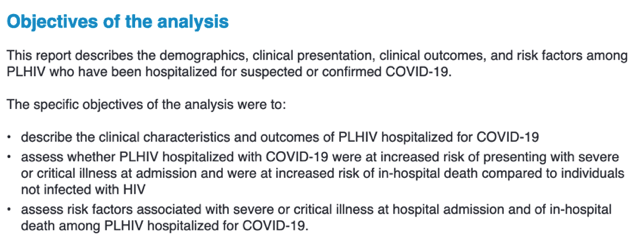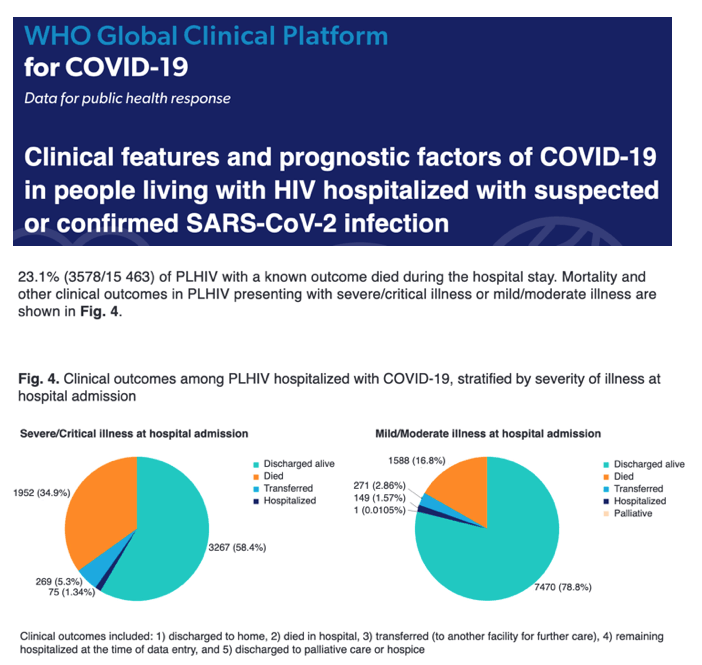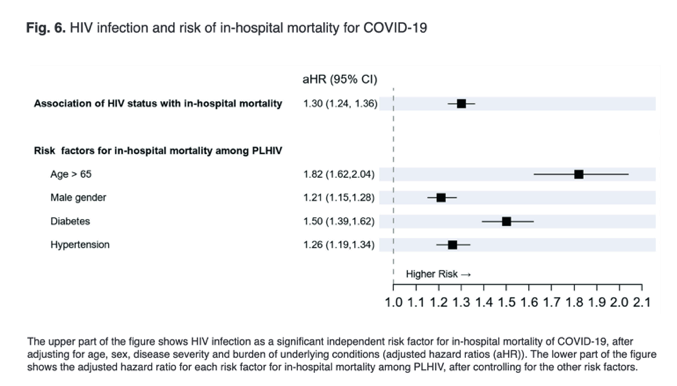| |
WHO warns that HIV infection increases risk of severe and critical COVID-19
|
| |
| |
Download the PDF here
https://www.who.int/news/item/15-07-2021-who-warns-that-hiv-infection-increases-risk-of-severe-and-critical-covid-19?utm_source=miragenews&utm_medium=miragenews&utm_campaign=news
15 July 2021
Departmental news

A new WHO report confirms that HIV infection is a significant independent risk factor for both severe/ critical COVID-19 presentation at hospital admission and in-hospital mortality. Overall, nearly a quarter (23.1%) of all people living with HIV who were hospitalized with COVID-19, died.
The report is based on clinical surveillance data from 37 countries regarding the risk of poor COVID-19 outcomes in people living with HIV (PLHIV) admitted to hospital for COVID-19.
It found that the risk of developing severe or fatal COVID-19 was 30% greater in PLHIV compared to people without HIV infection. Underlying conditions such as diabetes and hypertension are common among PLHIV. Among male PLHIV over the age of 65 years, diabetes and hypertension were associated with an increased risk of more severe and fatal COVID-19. These conditions are known to put people at increased risk of severe disease and death.
This highlights the need for PLHIV to stay as healthy as possible, regularly access and take their ARV medications and prevent and manage underlying conditions. This also means that people living with HIV - independent of their immune status - should be prioritized for vaccination in most settings. An informal WHO poll revealed that out of 100 countries with information, 40 countries have prioritized PLHIV for COVID-19 vaccination.
The analysis is informed by data from WHO's Global Clinical Platform for COVID-19, which collects individual-level clinical data and characterizes COVID-19 among individuals hospitalized with suspected or confirmed SARS-CoV-2 infection around the globe.
Later this week, WHO will also release updated Guidelines on HIV prevention, testing, treatment, service delivery and monitoring. These guidelines provide over 200 evidence-informed recommendations and good practice statements for a public health response to the prevention, testing, and treatment of people living with HIV. These recommendations help to ensure that people with HIV can start and continue treatment during times of service disruption as a consequence of the COVID-19 pandemic.
"The report released today will have important policy implications - providing data to confirm that HIV is a risk for poor outcomes from COVID-19 - and increases the urgency to see all PLHIV on treatment and with access to COVID-19 vaccinations." said Dr Meg Doherty, Director of WHO's Global HIV, Hepatitis and STI Programmes.
HIV continues to be a major global public health issue, having claimed 34.7 million lives so far. To reach the new proposed global 95-95-95 targets set by UNAIDS, countries need to redouble efforts to avoid increasing HIV infections due to HIV service disruptions during COVID-19 thereby slowing down the public health response to HIV.
-------------------------

HIV infection and risk of severe or critical illness at hospital admission
We assessed whether HIV infection was independently associated with a higher risk for severe or critical presentation of COVID-19 at hospital admission.
In this hospitalized population, PLHIV were at increased risk of severe or critical disease at hospital admission (aOR 1.06, 95% CI 1.02-1.11) compared to HIV-negative individuals, after adjusting for age, sex and the presence of underlying conditions (diabetes, tuberculosis, malignant neoplasms and chronic cardiac and pulmonary diseases). By including in the model the number of underlying conditions (comorbidity burden) rather than individual conditions, we found a similar risk of severe or critical disease (aOR 1.13, 95% CI 1.09-1.17) (Fig. 5.)
A sensitivity analysis was repeated to assess the impact of the country of origin on the severity outcome. After excluding data from South Africa, a total of 38 774 cases were available. Of those, 840 were people living with HIV, and 425 had information on severity status. In this analysis, HIV positive status remained an independent risk factor for severe/critical illness at hospital admission (aOR 2.27, 95% CI 1.73-2.97) after adjusting for age, sex and the presence of underlying conditions (diabetes, neoplasms and chronic cardiac disease).
Risk factors associated with severe/critical illness among people living with HIV admitted to hospital with COVID-19.
We assessed the associations between potential risk factors and severe/critical illness at hospital admission in this sample of PLHIV. After adjusting for age, sex, and underlying conditions (diabetes and hypertension), we found that PLHIV who were >65 years of age (aOR 1.62, 95% CI 1.41-18.7), male (aOR 1.21, 95% CI 1.23-1.31), with diabetes (aOR 1.10, 95% CI 1.03-1.22) or hypertension (aOR 1.54, 95%CI 1.41-1.68) had an increased risk of severe or critical illness at hospital admission after controlling for the other risk factors. All estimates were significant at p<0.0001 level (see Fig. 5., below).

Risk factors associated with in-hospital mortality among people living with HIV admitted to hospital with suspected or confirmed COVID-19.
We also assessed the relationship between potential risk factors predicting in-hospital mortality in this sample of PLHIV. Among PLHIV, being >65 years of age (aHR 1.82, 95% CI 1.62-2.04), male (aHR 1.21, 95% CI 1.15-1.28), having diabetes (aHR 1.50, 95% CI 1.39-1.62) and hypertension (aHR 1.26, 95% CI 1.19-1.34) increased the risk of in-hospital death after controlling for the other risk factors. All estimates were statistically significant with p<0.0001. (Fig. 6., lower section).
report excerpts:
A sensitivity analysis was repeated to assess the impact of the country of origin on the severity outcome. After excluding data from South Africa, a total of 38 774 cases were available. Of those, 840 were people living with HIV, and 425 had information on severity status. In this analysis, HIV positive status remained an independent risk factor for severe/critical illness at hospital admission (aOR 2.27, 95% CI 1.73-2.97) after adjusting for age, sex and the presence of underlying conditions (diabetes, neoplasms and chronic cardiac disease).
We performed a subgroup analysis, stratifying mortality risk by WHO geographic region. After adjusting for age, sex, underlying conditions and clinical presentation at hospital admission (mild/moderate versus severe/critical illness), HIV infection was independently associated with an increased risk for in-hospital mortality in the WHO African Region (aHR 1.29, 95% CI 1.23-1.34) but not in the WHO European Region (aHR 0.59, 95% CI 0.29-1.2) or the WHO Region of the Americas (aHR 0.92, 95% CI 0.37-2.31). For other Regions, modelling for mortality outcomes was not possible due to the limited sample size.
A sensitivity analysis was repeated to assess the impact of the country of origin on the mortality. When excluding data received from South Africa (resulting in a total of 311 HIV positive cases compared with 7474 HIV negat ive cases with a known outcome), the risk of death in people living with HIV hospitalized with COVID-19 remained elevated, but was no longer statistically significant (aHR 1.16, 95% CI 0.90-1.51). Adjustment for covariates other than sex and age was not possible due to the limited sample size.
In this analysis, the data are predominantly from South Africa. Although this may limit the generalizability of the results, it is worth noting that this country is the epicenter of the HIV pandemic and has the largest AIDS epidemic globally, accounting for 20% of all people living with HIV worldwide and 20% of new HIV infections.
Not all potentially relevant risk factors, such as body mass index (BMI), were considered in the regression model due to insufficient data reported; and this may have influenced our findings. In addition, findings only refer to in-hospital mortality and do not capture information on post-discharge outcomes, thus potentially unde restimating the impact of HIV infection on overall mortality due to COVID-19.
|
|
| |
| |
|
|
|